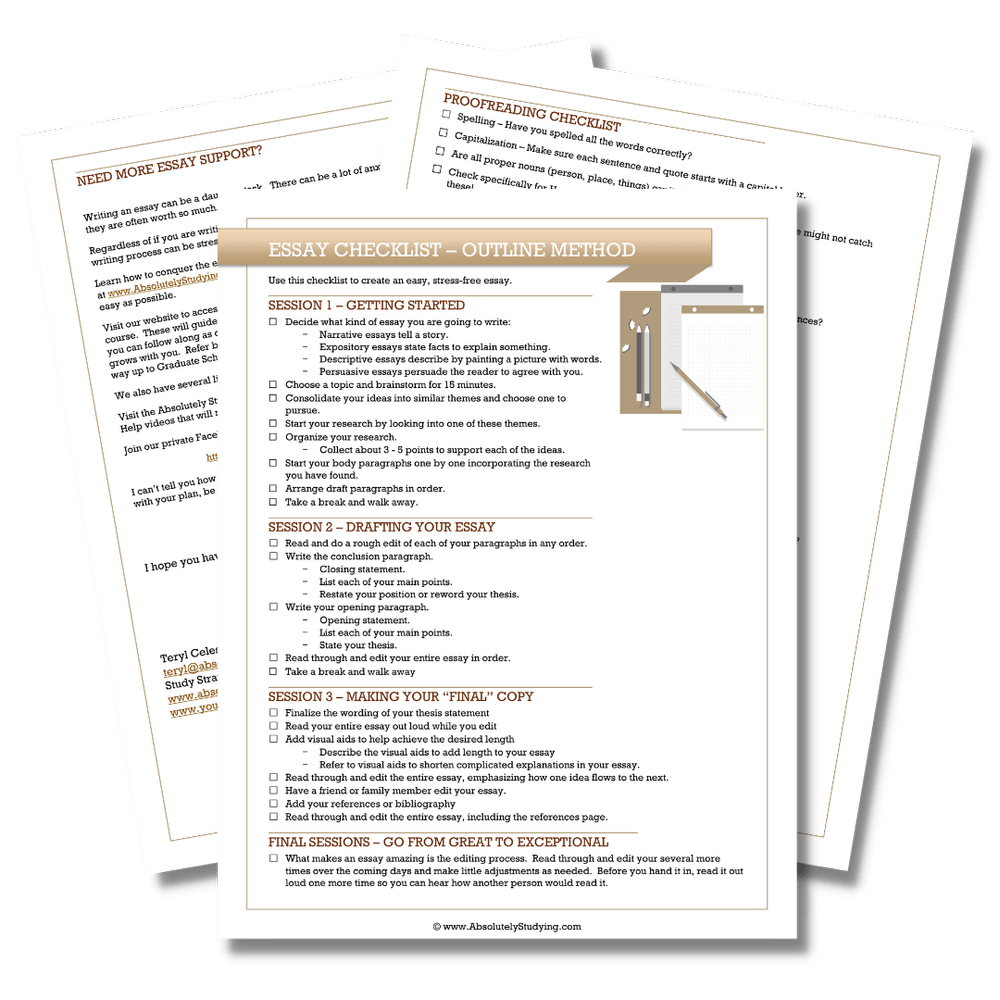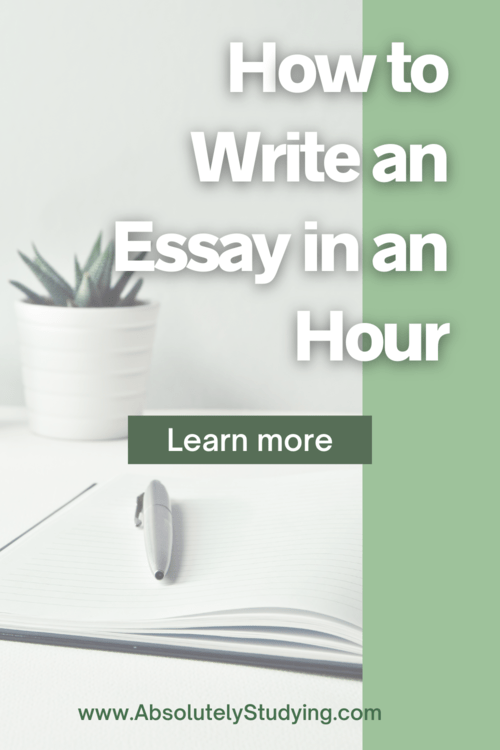How to Write an Essay in an Hour With the Deadline Looming
How to Write an Essay in an Hour With the Deadline Looming
The quick and dirty guide to essay writing when you are down to the wire.
Essay Writing & Proofreading Checklist
This checklist will guide you through the process of:
Choosing a subject
Creating your draft
Revising your essay
Proofreading step-by-step
Getting it ready to submit
This easy-to-follow guide will lead you through the entire process quickly and efficiently.
* Disclaimer * Some of the posted links are affiliate programs. By clicking these links, I may receive monetary compensation. This will not alter the price or change the buyer's experience.
So, what happens when you are so overwhelmed that an assignment slips through the cracks?
We have all been there. Whether we are just too busy to give a project the proper attention it needs or when we blank out and completely forget the due date is looming. Even the most organized students are going to drop the ball at some point.
Sometimes, this happens with a big assignment. When you are down to the wire, you need to get anything handed in before you get that big fat zero. Desperate times call for desperate measures.
If you expect an AI-centered walkthrough, this article is not for you. While AI definitely has its place in this world and, arguably, in education, having it write your essay for you is not it. Risking expulsion is never worth the generic mediocracy you will be handing in.
Instead, this is going to be your life-saving, for emergency use only, down-to-the-wire guide to write a paper and submit it in an hour. We are under a time crunch here, so the very first thing you might want to do, if you haven’t already, is to hop on a free trial of Grammarly.
This will really help you streamline the editing process so you can focus on putting words on the paper first!
Secondly, grab a timer or a stopwatch. The one on your phone is fine. We have a strict time schedule for each step to stay on track. Make sure you don’t wander off-topic on any other apps or websites, though.
Finally, grab my free essay checklist. This will help you to visualize the progress you are making. This easy-to-use printable will guide you through the essay writing and editing process. It will keep track of each step as you work, so you don’t leave anything out.
It has all of my best practices that are left out of this guide. This way, if you find yourself with some extra time, you can go back and tweak your essay to perfection!
You can also bookmark our Ultimate Guide to Essay Writing for the next time you have a big essay due!
Create an amazing essay & proofread it with ease!
A simple, stress-free essay is just a click away.
Can you write an essay in an hour?
Obviously, writing an essay in an hour is not ideal, but it is also not outside the realm of possibilities. You can write a 500-word essay in an hour, but as the length increases, so does the difficulty.
As your essay length grows, the quality will probably decrease. This is because a lot of what makes your writing good is the editing process. Going over what you are writing and adjusting phrasing and word repetitions is much easier when you read it back. It also helps you avoid writer's block if you are not constantly stopping to ensure that everything is perfect the first time.
If you are highly constrained on time, you will not have the opportunity to go back over your work. This is going to make it much easier to miss simple spelling and grammar errors. It’s also going to stop you from perfecting the tone, flow, and cohesion of the language used.
So, is it possible to write an essay in an hour? Yes. Should you? That depends on the quality of the paper you want to produce and the grade you want to get.
How to Write an Essay in an Hour
Now it’s time to get to work! Gather everything you will need for the writing process to your desk, so you don’t have to waste time searching later. Get yourself a drink and a snack as well. Your brain works best when it is well hydrated, and chewing actually helps you think!
I usually suggest handwriting in the first few stages of writing an essay, but you can ignore that today. You need to default to whatever your fastest method of capturing ideas is. If you are a one-handed typer, then go ahead and write it out. Just make sure you don’t get caught up on making your writing at all legible.
We are going to be moving the information around a lot over this series of steps. It’s going to get pretty messy. Just trust the process and watch it come together.
Step 1 – 5 minutes – Brainstorm your ideas
On a sheet of paper, write out what it is you are trying to prove. Don’t worry about phrasing or how it looks. We just need to get the central idea of your essay. Later, this is going to become the thesis statement, but it’s not yet.
Too many writers struggle because they want to start the essay with the perfect thesis. We don’t have time for that. Capture the idea, and then it’s time to move on.
Next, you need to list some ways you can prove it. These can be things you already know to be true or assumptions you might have heard. List at least 3 of them out.
These three are going to form your supporting arguments. If you know they are accurate and have factual data to support it, quickly jot that down, too.
If you are doing an opinion piece or don’t need research for this particular essay, just write down all of the points you want to hit on throughout it. Write them out in point form so that we are not wasting any time.
There is no need to be flashy. There is no need to put it in eloquent, beautiful words. Just write it out quickly and dirty. That’s all you need.
What you are doing here is making a road map. You are plotting all of the landmarks for your essay that you can fill in as you go.
Don’t do any research at this stage. We will continue to do that next. This is going to structure our research blocks so that we will not wander off-topic. We need to save every single second we can, so staying on task is essential.
Step 2 – 15 minutes – Research and outline the body paragraphs.
There are generally three body paragraphs in a 500-word essay. If you are writing a shorter essay, then that is all you have to worry about.
If your essay is much longer than 500 words, we can treat each paragraph as a sub-section instead. They will still be centred around a single supporting argument. But, they may need more than one paragraph to comprehensively communicate the idea.
Copy and paste each of these supporting arguments onto their own page, along with any data points you listed beneath them. We are going to now build out the bones of the paragraphs.
Go to Google Scholar and type in the idea you are trying to prove and your argument to support it. Google will populate a bunch of articles that will discuss your query. At the bottom of the description, you will also be told how many times this article has been cited.
Start with higher cited articles and skim through the abstract. Make sure it proves your argument, and then you can use it as your source. As you go through the abstract, make notes in point form of the other findings in the article.
The abstract of a scientific article will often show a ton of helpful information. You can also read through the discussion part of the paper as well to get useful details.
Do not copy it out word for word. We will not have time to rephrase it later. Instead, use your own words as much as possible to save time on it in the future. If you struggle with this, use a thesaurus.
It is crucial that you make sure that if you did any research for this paper, you are putting that research into your own words. Even poorly rephrased segments can be considered plagiarism.
Plagiarism is a huge problem in essays and academic writing. Sometimes, you don’t even realize that you plagiarize, especially if you don’t rewrite the phrases immediately. Unfortunately, accidental plagiarism is not a defence, and you can still get in a ton of trouble.
If you copy something straight out of a textbook or journal and you accidentally write it down verbatim, you might forget later or not change it enough in your essay. So, it is better to change things as you write them.
Did you know that you still have to cite yourself? Even if you are quoting your own work, you can get into trouble for plagiarizing yourself. If you ever have to reference a lab report or past paper you submitted, cite it properly. Never assume that anything is fair game.
Try to spend no more than 5 minutes on each of your supporting arguments. You only need one or two good sources for each paragraph before you move on to the next. It is always better to dive deep and flesh out a topic in detail than it is to just spew facts. If we stick to just a couple of strong arguments, you leave room for this elevated level of elaboration.
Study Skills Digital Course
Learn how to create a stress-free comprehensive study strategy!
Step 3 – 15 minutes – Fill out your paragraphs
Once you have the basic outline of facts for each supporting argument, you can go back and add analytical and transition sentences.
The ideas in each paragraph should flow logically into the next. If you have to rearrange any of the facts around, be sure to do it. Between each point, add one or two sentences that explain why it is relevant or how it proves your supporting argument.
To wrap up the paragraph, add a couple of sentences that explain why what you have just discussed supports the idea you are trying to prove.
Try to spend no more than 5 minutes on each paragraph. If you can’t get the wording you want, write it down in whatever words come into your head and move on to the following sentence. We can clean it up in editing, and the premium version of Grammarly is usually super helpful when you are trying to rephrase an idea.
Step 4 – 5 minutes – Write the conclusion paragraph
Start with a sentence that analyzes and reflects on the data you just presented. Here, we want to summarize the journey we have just taken the reader on. This is the beginning of the wind-down for your essay. We want to remind the reader of the facts and why they support what we are trying to prove.
The next three sentences will be for each of your supporting arguments. State them one by one, along with any transition words or phrases that link them. You don’t want this to sound like a list, so each supporting argument should have its own sentence. This, again, reminds the reader of the facts we’ve previously discussed.
It is also critical that you don’t introduce any new information in this paragraph. We are only revisiting what you have already proven. By now, the reader should already be familiar with all of the details and supporting evidence.
Finally, the following two or three sentences should be used to set up and transition to why the idea that you were trying to prove has now been established. These are the final words that your audience will take in, so you want them to be strong and to the point. Don’t waiver on your topic or use any wording that will make you seem uncertain.
These are the facts you are stating. You have already proven them. The reader now has no choice but to agree with you. That’s the point of the essay. Make this assumption as you pen these lines.
Step 5 – 5 minutes – Write the introduction paragraph
Start with an attention-grabbing line. You can make a bold statement or ask a question, whichever fits your tone the best.
This is not to be confused with the thesis statement. At this point, we are just setting the stage and priming with what we want to prove. We want to intrigue the reader, so they are excited to learn more.
Next, we want to lay out the evidence we are going to present. Just like you did in the conclusion, dedicate a sentence to each supporting point that will prove your idea. Don’t dive into any facts. We just want them to know what they can expect to learn about.
Finally, add one or two transition sentences before completing your thesis statement. This is when you finally get to tell the reader the opinion you will prove throughout the essay.
This paragraph does not have to be too long. We already presented all the data and details when we wrote the body paragraphs. This is just an outline of what the reader can expect.
Remaining time – Read through your essay from beginning to end and edit
If you have installed the Grammarly extension, now is the time to turn it on. Go through and read your essay from beginning to end. Double points if you read it out loud!
Make any changes to the wording to allow better flow and cohesiveness. Be sure that each argument flows in a logical order. Try not to have too many words that repeat or that stick out. Fancy words might be nice, but if they don’t fit, it can ruin the immersion for the reader.
Be as careful as you can. If you are in a seriously tight time crunch, this might be your only edit. It is so easy to make silly mistakes like “do “instead of “to” and things like that.
Before you submit your essay, you should also read over your instructions and rubric once more. Make sure you are giving the marker what they are looking for.
The most common reason students lose marks is not supplying what was asked for. You won’t believe how often this happens. As you read through, check off each element and make sure you have included it in your submission.
Finally, a protip, don’t start with the strongest argument right out the gate. Start with the second strongest argument. Then, put any weaker ones in between and end with the strongest.
When you start with your second strongest argument, it really lures them in. It pulls them in and makes them think. That’s a really great point.
Now, you might back up that second argument with the weaker ideas. Those still need to reinforce what you are trying to prove and make some excellent points. The problem with this middle paragraph is that it is often forgettable. People tend to remember the first thing and the last thing you tell them. Putting your strongest argument last lets you set up that final argument so you end on a solid note.
This final argument is where you need to flex your writing muscles. This is the “take it home” paragraph where you should destroy any questions left in the readers’ minds.
If you find any spare time in your schedule, edit this essay over and over. Each time you edit it, you will make it better. You can literally write an essay in an hour and then edit it to perfection with all your remaining time.
Just imagine that each time you read through and tweak your essay, you add another 5% or 10% to the final grade. Your essay can start out literally sounding like trash; then you save it through the editing process.
Print off my free essay checklist to help you with the whole writing and editing process. It is a straightforward guide that can help you track each step of your essay. This way, if you find yourself with some extra time, you have simple recommendations for making your assignment better.
I would like to be transparent so that there are no misunderstandings. As an affiliate, I may earn a small commission from any products linked in this post. This is not a sponsored post, and I was not asked to recommend these products. These are products that I genuinely love and wanted to share with my audience.







